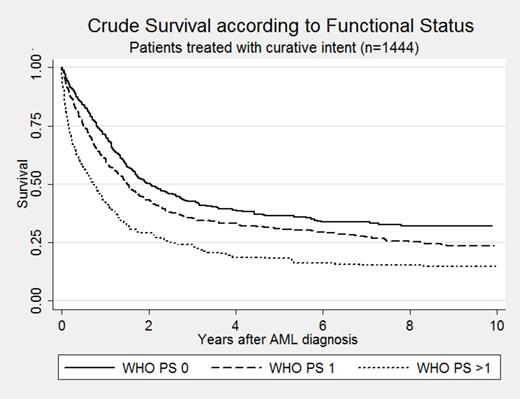Abstract

With an aging population, the burden of comorbidity in AML patients is expected to increase. Evidence on how to integrate comorbidity and functional status into clinical decision making is sparse and prior studies have been predictive and limited by single center study design, and small sample sizes.
To examine the impact of comorbidity and WHO Performance Status (PS) on intent of treatment in Danish AML patients. Secondary, to determine the prognostic impact of comorbidity and PS on achievement of complete remission, short- and long-term mortality in AML patients treated with curative intent.
In a nationwide cohort study, we identified all AML (non-promyelocytic leukemia) patients diagnosed in Denmark from 2000-2013 using a population-based leukemia registry (n=2785) which prospectively collects clinical data. We excluded patients with unknown intent of treatment (n=25). We identified comorbid conditions through the Danish National Registry of Patients. Comorbidity was evaluated according to presence of 17 of the 19 chronic diseases (HIV and leukemia excluded) in the Charlson Comorbidity Index with separate adjustment for all diseases associated with secondary AML (modified CCI (mCCI)). Crude and adjusted odds ratios (OR) and corresponding 95% confidence intervals (CI) for receiving treatment with curative intent were estimated. We used Cox proportional hazards regression to assess the influence of comorbidity and performance status on 90-day and 90-day to 3-year mortality in patients treated with curative intent (n=1444) by estimating crude and adjusted mortality ratios (MRs) and corresponding 95% CIs. We adjusted for age, gender, leukocyte count, prior chemo-/radiotherapy, and prior hematological diseases.
Of 2760 patients 52% were treated with curative intent. Median age was 69 years (palliative intent: 78 vs. curative intent: 58). Overall, 60% of patients did not have any comorbidity, 26% had 1 comorbid disease, and 13% had 2 or more comorbidities. In patients treated with curative intent, the corresponding prevalences were 76%, 19%, and 6%. Overall, 26% of patients had PS=0, 42% had PS=1, and 32% had PS ≥2. The corresponding figures in patients treated with curative intent were 33%, 47%, and 20%. Dementia and heart failure were the two individual comorbid diseases most strongly associated with opting-out of intensive treatment (prevalence ratio 0.11 (95%CI 0.01-0.67) and 0.24 (95%CI 0.15-0.37). In patients treated with curative intent, those with comorbidity had lower complete remission rate than those without comorbidity, 66% (95%CI 60.7-70.7) vs. 74% (95%CI 70.8-76.9) whereas choice of chemotherapy regimen and dose did not differ. Compared to patients without comorbidity (mCCI=0), the adjusted ORs for treatment with curative intent were 0.57 (95%CI 0.41-0.73) for patients with 1 comorbid disease and 0.32 (95%CI 0.22-0.47) for 2 or more. Compared to patients with PS=0, the adjusted ORs of treatment with curative intent were 0.80 (95%CI 0.58-1.09) for PS 1, 0.45 (95%CI 0.31-0.65) for PS 2, and 0.09 (95%CI 0.05-0.14) for PS≥3.
Crude survival curves according to comorbidity and PS are shown below. Crude and adjusted MRs are listed in table 1.
Crude and adjusted 90-day and 90-day to 3-year MRs according to mCCI and PS
| . | . | 90-day mortality . | 90-day to 3-year mortality . | ||
|---|---|---|---|---|---|
| mCCI . | n . | Crude MR (95%CI) . | Adjusted MR (95%CI) . | Crude MR (95%CI) . | Adjusted MR (95%CI) . |
| 0 1 ≥2 | 1091 164 189 | 1.0 1.79 (1.26; 2.53) 1.35 (0.94; 1.93) | 1.0 1.16 (0.77; 1.75) 0.90 (0.57; 1.41) | 1.0 1.51 (1.20; 1.91) 1.54 (1.23; 1.91) | 1.0 1.26 (0.97; 1.63) 1.05 (0.81; 1.38) |
| WHO PS | |||||
| 0 1 ≥2 | 480 681 283 | 1.0 1.54 (1.08; 2.21) 4.19 (2.93: 6.00) | 1.0 1.29 (0.87; 1.93) 3.80 (2.55; 5.65) | 1.0 1.21 (1.02; 1.44) 1.46 (1.17; 1.83) | 1.0 1.11 (0.92; 1.34) 1.41 (1.10; 1.80) |
| . | . | 90-day mortality . | 90-day to 3-year mortality . | ||
|---|---|---|---|---|---|
| mCCI . | n . | Crude MR (95%CI) . | Adjusted MR (95%CI) . | Crude MR (95%CI) . | Adjusted MR (95%CI) . |
| 0 1 ≥2 | 1091 164 189 | 1.0 1.79 (1.26; 2.53) 1.35 (0.94; 1.93) | 1.0 1.16 (0.77; 1.75) 0.90 (0.57; 1.41) | 1.0 1.51 (1.20; 1.91) 1.54 (1.23; 1.91) | 1.0 1.26 (0.97; 1.63) 1.05 (0.81; 1.38) |
| WHO PS | |||||
| 0 1 ≥2 | 480 681 283 | 1.0 1.54 (1.08; 2.21) 4.19 (2.93: 6.00) | 1.0 1.29 (0.87; 1.93) 3.80 (2.55; 5.65) | 1.0 1.21 (1.02; 1.44) 1.46 (1.17; 1.83) | 1.0 1.11 (0.92; 1.34) 1.41 (1.10; 1.80) |
The chance of being allocated to intensive chemotherapy decreased dramatically with increasing number of comorbid diseases and increasing PS. Surprisingly, among patients treated with curative intent presence of comorbidity was not associated with an increase in short-term mortality, and if any, only a slight increase in long-term mortality. High PS was strongly associated with both short- and long-term mortality. Our findings may be explained by the selection process before treatment with curative intent and raises the question whether more patients with comorbidity and low PS at time of diagnosis may benefit from intensive treatment.
No relevant conflicts of interest to declare.
Author notes
Asterisk with author names denotes non-ASH members.

This icon denotes a clinically relevant abstract



This feature is available to Subscribers Only
Sign In or Create an Account Close Modal